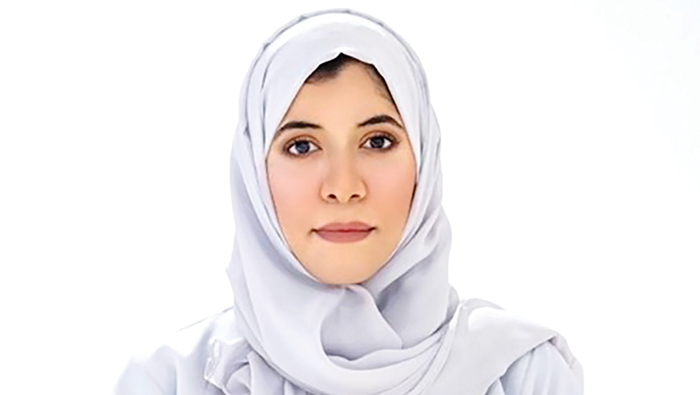
Muscat: Principal investigator Shahad Mattar Al Yaqoubi from Sultan Qaboos University (SQU)is among the winning innovative research projects in the 9th National Research Award, organised by the Ministry of Higher Education, Research and Innovation.
She has won the award in the Young Researcher’s category for her work on ‘Fresh-saline water dynamics in coastal aquifers: Sand tank experiments with MAR-wells injecting at intermittent regimes.’
Behind the idea of the research project, Shahad Al Yaqoubi explained that it is very important to gain a better understanding of seawater intrusion (SWI) problem in coastal aquifers for better management of groundwater resources.
In Oman, SWI has become a phenomenon that harms urban water supply and farming activities in Al-Batinah and Salalah coastal areas.
One of the wide-spreading approaches to control SWI is through enhancing aquifer recharge to maintain the hydraulic gradient seaward direction. However, the successful implication of managed aquifer recharge (MAR) to coastal aquifers requires a good understanding of the dynamics of intruding saline water and its response to different external stresses emerging under MAR practices.
Shahad stated that MAR is a mean by which water of good quality (relatively low salinity and density as compared with seawater) is injected into the aquifer to enhance its storage for later recovery.
Implementing MAR may both improve the quality of initially present groundwater and control SWI by creating hydraulic barriers. SWI has been widely investigated in physical sandbox-field experiments and analytical–numerical mathematical models.
However, to the best of the research team’s knowledge, there were no studies of a commingled dynamics of the triad of saline water, natural fresh groundwater and freshwater injected in MAR using sand tank experiments similar to the one presented in their research project.
Sand tank experiments at a laboratory scale is an excellent tool that allows better understanding and visualisation of what is most likely happening in real aquifers.
The main objective of this paper, according to Shahad, was to study SWI under MAR practices using sand tank experiments. The effect of the depth of screens of injection wells, their loci with respect to the toe of the saline water tongue, the injection volume, on the dynamics of the saltwater-freshwater interface were assessed and quantified.
For the findings, results of the sand tank experiments presented that injecting water away from the saline water wedge was less effective to decrease the SWI by 32% to 61.4% compared to when MAR was practiced near it depending on the injected volume (0.5 L to 1.4 L). Injection of water inside the transition zone caused to delay the re-intrusion of saline water because the injection water built a hydrological barrier against the saline water intrusion. Injection of water close the coastal boundary caused to loss of the injected water through the coastal boundary and caused less effect to push the saline water wedge seaward direction.
Moreover, Shahad added that the results showed that injection at deeper depth was less effective in decreasing the SWI compared with the scenario when the injection was performed at the shallow depth. For example, injecting 1.06 L of freshwater near the toe of saline water interface at deeper depth (42 cm) decrease less salinized volume by 25.5% compared to when the injection of same volume was at shallow depth (22.5 cm). During the injection, it was also very important to monitor the height of the water table mound to increase the effectiveness of MAR in mitigating SWI because a high-water table mound may consequence the rapid discharge of the injected water happening through the discharge boundary and therefore less effect in reducing SWI.
Shahad stressed that the optimisation of MAR practice (in terms of the location of injection, depth of injection, duration of injection, rate and volume of injection, along with keeping water balance for the aquifer) was essential to avoid failure or ineffectiveness of MAR to reducing SWI problem.
She maintained that the effect of MAR in controlling SWI was definitely site-specific, depending on geological and hydrogeological features. Hence developing a good understanding of the dynamics of both the injected water and SWI in small-scale experiments will be of help for numerical and analytical modeling, and eventually, successful implementation of MAR. Sand tank experiment at a laboratory scale is an excellent tool that allows better understanding and visualization of SWI phenomena. The obtained experience and knowledge definitely will help in a better design of successful MAR systems for the mitigation of SWI.
Shahad mentioned that the research team included Dr. Ali Al Maktoumi, Prof. Anvar Kacimov, Prof. Osman Abdalla and Mr. Mohammed Al Belushi. The paper was published in the Journal of Hydrology in 2021 with an impact factor of 6.708.
As for her win, Shahad Al Yaqoubi stated that she felt “a sense of pride and happiness, especially since the project won the National Research Award among the many participating researchers. Winning this award helped me get an opportunity to participate in the Annual Research Forum. Through this forum, we were able to convey the general idea of the project and the results of the study, and its importance to the decision-makers in Oman.”